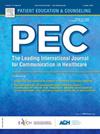Considering health literacy in communication about medications between nurses and patients with heart failure: A cross sectional observational study
IF 2.9
2区 医学
Q2 PUBLIC, ENVIRONMENTAL & OCCUPATIONAL HEALTH
引用次数: 0
Abstract
Objectives
To explore the content, style, and initiation of medication-related discussions between nurses and patients to understand how nurses support patients with heart failure, especially those with inadequate health literacy.
Methods
A cross-sectional design was conducted to observe medication-related conversations between nurses and patients with heart failure in four Dutch outpatient clinics. Conversations were audio-recorded and analyzed using MEDICODE, focusing on content, communication style (monologue or a dialogue), and initiation of the content themes. Health literacy was assessed using the NVS-D and the SBSQ. Results between health literacy groups were compared with descriptive analyses.
Results
A total of 56 patients and 14 nurses participated in the study. Patients classified by one or both of the instruments as having inadequate health literacy (n = 33; 59 %) were generally older, had lower educational levels, and were more often accompanied by informal caregivers. Key themes discussed in the medication-related conversations included how the medication was identified (‘medication designation), its dosage and instruction, main effects, side effects, attitude or emotions and other (‘various’) themes. The ‘medication designation’ theme was significantly more frequently discussed in the group with adequate health literacy, whereas ‘attitude or emotions’ and ‘various themes’ were more commonly discussed among those with inadequate health literacy. Most conversations were nurse-initiated and tended to be monologues, with nurses mainly serving as information providers.
Conclusions
Nurses primarily initiated and dominated medication-related discussions with a focus on factual aspects of medication, while patients initiated more discussions about their concerns regarding medication. While there was overlap in the topics discussed, notable differences emerged between patients with adequate and inadequate health literacy.
Practice Implications
Improving communication strategies, such as structuring conversations and adopting dialogic approaches may improve patients’ engagement and understanding of medication use, leading to more effective management of their condition, particularly benefiting patients with lower health literacy.
考虑健康素养在护士和心衰患者药物沟通中的作用:一项横断面观察性研究
目的探讨护士与患者药物相关讨论的内容、方式和发起方式,以了解护士如何支持心力衰竭患者,特别是健康知识不足的患者。方法采用横断面设计,观察荷兰四家门诊护士与心衰患者之间的药物相关对话。使用MEDICODE对对话进行录音和分析,重点关注内容、交流风格(独白或对话)以及内容主题的启动。使用NVS-D和SBSQ评估健康素养。对健康素养组间的结果进行描述性分析比较。结果共56名患者和14名护士参与了研究。由一种或两种工具分类为卫生知识不足的患者(n = 33;59 %)一般年龄较大,受教育程度较低,并且更多地由非正式照顾者陪同。在与药物有关的对话中讨论的关键主题包括如何确定药物(“药物名称”),其剂量和说明,主要作用,副作用,态度或情绪以及其他(“各种”)主题。“药物指定”主题在具有适当健康素养的组中讨论的频率明显更高,而“态度或情绪”和“各种主题”在健康素养不足的组中讨论的频率更高。大多数谈话是护士发起的,往往是独白,护士主要作为信息提供者。结论护士主要发起和主导用药相关讨论,关注用药的事实方面,而患者则更多地讨论他们对用药的担忧。虽然所讨论的主题有重叠之处,但在卫生知识充分和不充分的患者之间出现了显著差异。实践意义改进沟通策略,如组织对话和采用对话方法,可提高患者对药物使用的参与和理解,从而更有效地管理其病情,尤其有利于卫生知识普及程度较低的患者。
本文章由计算机程序翻译,如有差异,请以英文原文为准。
求助全文
约1分钟内获得全文
求助全文
来源期刊

Patient Education and Counseling
医学-公共卫生、环境卫生与职业卫生
CiteScore
5.60
自引率
11.40%
发文量
384
审稿时长
46 days
期刊介绍:
Patient Education and Counseling is an interdisciplinary, international journal for patient education and health promotion researchers, managers and clinicians. The journal seeks to explore and elucidate the educational, counseling and communication models in health care. Its aim is to provide a forum for fundamental as well as applied research, and to promote the study of organizational issues involved with the delivery of patient education, counseling, health promotion services and training models in improving communication between providers and patients.
 求助内容:
求助内容: 应助结果提醒方式:
应助结果提醒方式:


